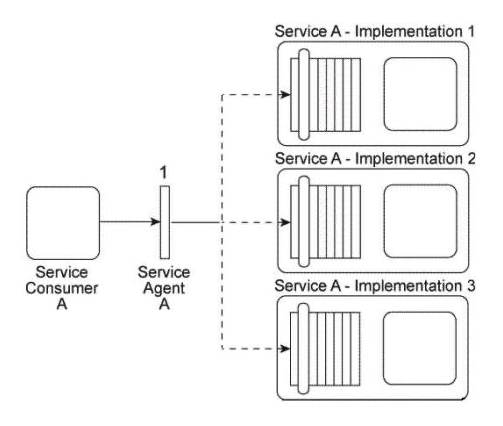Multiple Choice
Service Consumer A sends a message to Service A. There are currently three duplicate implementations of Service A (Implementation 1, Implementation 2, Implementation 3) . The message sent by Service Consumer A is intercepted by Service Agent A (1) , which determines at runtime which implementation of Service A to forward the message to. All three implementations of Service A reside on the same physical server.  You are told that after Service A was deployed, each of its three implementations was claimed by a different IT department, which means each implementation of Service A has a different owner. You are informed that a new service capability will soon need to be added to Service A . This service capability will introduce new business logic specific to Service A as well as logic required to access a shared database. What steps can be taken to ensure that the service owners will each add the service capability in a consistent manner to their respective implementations of Service A?
You are told that after Service A was deployed, each of its three implementations was claimed by a different IT department, which means each implementation of Service A has a different owner. You are informed that a new service capability will soon need to be added to Service A . This service capability will introduce new business logic specific to Service A as well as logic required to access a shared database. What steps can be taken to ensure that the service owners will each add the service capability in a consistent manner to their respective implementations of Service A?
A) The Contract Centralization pattern can be applied so that when the new service capability is added, the Service A service contract will become the primary contact point for Service A . This will avoid Service Consumer A or any other potential service consumer from being designed to access the shared database directly. The Service Abstraction principle can be applied to further hide the implementation details so that Service Consumer A and other service consumers are unaware of the fact that the shared database is being accessed.
B) The Legacy Wrapper pattern can be applied to establish a new wrapper utility service that will provide standardized data access service capabilities for the shared database. This will avoid Service A from having to access the shared database directly and will further support the application of the Service Loose Coupling principle between Service A and the new utility service. By abstracting the data access logic into the wrapper service, there is no need to add the new service capability to each implementation of Service A .
C) The Standardized Service Contract principle is applied to ensure that the new service capability is consistently added to the service contract of each implementation and that it extends the existing Service A service contract in a manner that is compliant with current design standards. The Service Loose Coupling principle is applied to ensure that the new service capability remains decoupled from the underlying logic and implementation so that Service Consumer A does not become indirectly coupled to any new logic or to the shared database.
D) None of the above.
Correct Answer:

Verified
Correct Answer:
Verified
Q12: Service A is an entity service that
Q13: The architecture for Service A displayed in
Q14: Service A is a task service that
Q15: It has been confirmed that Policy A
Q16: Service Consumer A sends a message with
Q18: Our service inventory contains the following three
Q19: Service Consumer A sends a message with
Q20: You are told that in this service
Q21: Services A, B, and C are non-agnostic
Q22: Service A is a task service that